Home
"Am Spiegelgrund" (Städtische Jugendfürsorgeanstalt “Am Spiegelgrund” Wien), part of the Niederösterreichische
Landes-Heil- und Pflegeanstalt für Nerven- und Geisteskranke 'Am Steinhof'; in March 1942 renamed Heilpädagogische Klinik der Stadt Wien "Am Spiegelgrund"; in Nov. 1942 divided intoWiener Städtische Nervenklinik für Kinder "Am Spiegelgrund" ("Municipal Mental Clinic for Children") apart from the Wiener Städtische Erziehungsanstalt "Am Spiegelgrund" ("Municipal Reformatory")
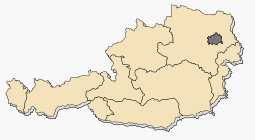
The Kinderfachabteilung in Vienna, the Städtische Jugendfürsorgeanstalt
“Am Spiegelgrund” Wien, operated from late July 1940 until May 1945. It
was the first of at least two "special children's wards" to open in
Austria, and the second one established overall. The
clinic's medical directors were Prof. Dr. Erwin Jekelius (until
early 1942) and Dr. Ernst Illing (since 1942), and responsible for the
"special children's ward" were Dr. Heinrich Gross, Dr. Margarethe
Hübsch, and Dr. Marianne Türk. Dr. Jekelius died in 1952 in a prison. Dr. Illing was sentenced to death and executed in
1946. Dr. Gross had an illustrious career (see below). Dr. Hübsch was
acquitted, and Dr. Türk sentenced to 10 year incarceration (she served
two).
Close to 800 children died in the special
children's ward in "Am Spiegelgrund," making it a site of one of
the largest number of children murdered. The "special children's
ward" was housed in pavilions 15 and 17.

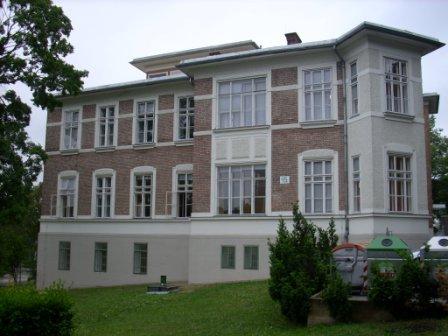
In newspaper reports in the immediate postwar period there was
little
question about the nature of the crimes - here illustrated by the
heading "The children's murderers of the Steinhof in the dock." This
illustrates that the murders were publically known in what Wolfgang
Neugebauer has called a brief anti-fascist period after WWII during
which perpetrators were persecuted.
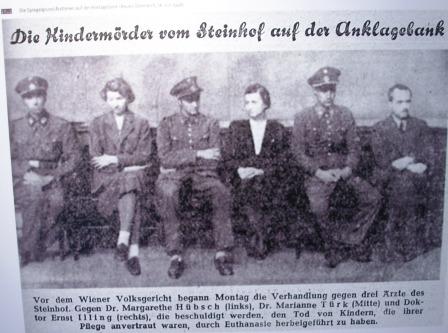 Source: Author's photo of exhibit at the Spiegelgrund (2009)
Source: Author's photo of exhibit at the Spiegelgrund (2009)
Dr. Gross was sentenced after World War II to two years for a
single case of manslaughter, but the verdict was set aside on a
technicality, and Dr. Gross became one of Austria's most prominent
forensic experts. When in the late 1970s the Committee for Critical
Medicine (Arbeitsgemeinschaft Kritische Medizin) under the leadership
of Dr. Werner Vogt made allegations about Dr. Gross concerning his
involvement in "children's euthanasia," the latter sued for slander and
damages but lost, with the High Court (Oberlandesgericht) making a
affirmative determination of
Dr. Gross's complicit involvement in and responsibility for the murders
that happened in the "special children's ward" - the beginning of the
end of Dr. Gross's medical career. The Arbeitgemeinschaft's
dispute with Dr. Gross followed an incident in which Friedrich Zawrel,
survivor of Spiegelgrund, recognized Dr. Gross as one of his torturers
then, and Dr. Gross then wrote up a spurious negative psychiatric
assessment to have Zawrel committed in order to cover up. This
case had come to the attention of the Committee for Critical Medicine.
In
1988,
the "year of reflection" (Bedenkjahr) inspired by the 50th anniversary of
Austria's integration with larger Germany (the "Anschluss"), two
commemorative plaques
were placed on the hospital's territory, with the inscription "In
commemoration of the victims in psychiatry of the National Socialist
State, and as a warning. Established in 1988." Another plaque with
the same inscription was placed in the vicinity as well. That year for
the first time a commemorative event took place that included staff. It
was dedicated to the victims of NS-psychiatry in the psychiatrical
establishments in Vienna. (see Gabriel/Neugebauer p. 9).
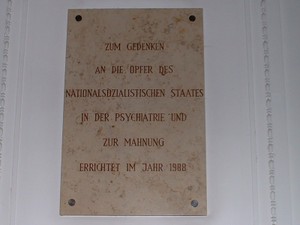
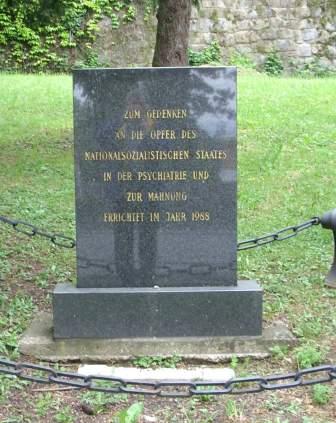 Source: http://www.nachkriegsjustiz.at/vgew/1140_baumgartnerhoehe.php
Source: http://www.nachkriegsjustiz.at/vgew/1140_baumgartnerhoehe.php
One
year later the room where Dr. Gross’s ghastly collection of brain
specimens of victims was housed in the cellar of the hospital's
pathology section was re-commissioned as a "room of commemoration,"
simply by putting up a plaque. The plaque displayed the following text:
"The Psychiatric Hospital Baumgartner Höhe established this room 50
years after the beginning of the murderous program against the sick and
disabled in commemoration of the children who died in the Wiener
Städtische Nervenklinik für Kinder Am Spiegelgrund." There was no
public acknowledgement about the re-commissioning of the room, and the
room was off limits to the general public, as access was apparently
only granted to nursing students as part of their training and,
occasionally, to journalists.
Sources: http://de.doew.braintrust.at/popup.php?t=img&id=304 and Salzburger Nachrichten, 19 Nov. 1994
The
presentation of the "room" in such a farcical way as a "memorial" was
soon recognized as scandalous, as brain
specimens from the victims, on the basis of which Dr. Gross had
launched his scientific career, remained stored in the basement of the
hospital. In 1992 the Green Party member and district councillor
Wolfgang Krisch suggested a burial of the specimens in an honorary
grave and a more
appropriate way of documenting the crimes of the past in the form of an
appropriate
memorial space. Dr. Wolfgang Neugebauer, then director of the
Documentation
Center of Austrian Resistance, also advocated for a more appropriate
form of commemoration and sought to have Dr. Gross finally criminally
prosecuted. Relatives of victims were scandalized by the way in
which remains of victims were presented as well. After discussions in
which suggestions for a different form of memorial were
rejected at first, the clinic's director, Dr. Gabriel, was amenable to
considering different options for commemoration, such as an exhibit of
the history of the hospital, including the Nazi period, a memorial, or
a documentation with the display of such specimens.
A burial
of the remains of the victims was at first made impossible by the criminal
investigations into Dr. Gross's criminal past, which commenced in 1997
after documents formerly inaccessible in the GDR implicated Dr. Gross,
which led to reports and inquiries by the magazine "profil" (M. Enigl),
the medical dissertation by Matthias Dahl, efforts by the directory of
the Documentation Center of Austrian resistence to have Dr. Gross
charged, the Green Party, and reporting in international news
organizations. Dr. Gross ended up being charged with murder in
1999
(suffering from dementia, he was never held accountable and died
in 2005).
The
remains of the children were buried in April 2002 at an honorary grave
that includes a plaque with the following inscription: "In memory of
the children and youths who as 'life unworthy of living' fell victim
to National-Socialist Euthanasia in the then children's clinic Am
Spiegelgrund in the years 1940 to 1945." A description of the event can be found here.
On
the occasion of this burial one month later a permanent exhibit
was opened up in pavilion 5, first floor, for which the Documentation
Center of Austrian Resistance was responsible. The group that was
charged with its conception included representatives of public and
civil organizations as well as scholars with a background in history,
medicine, and psychiatry. The exhibit had as its theme the
larger framework of Nazi medical crimes in Vienna and included a
commemorative display of some of the children, as they had been
photographed before their death, as well as some displays with texts.
It was
initially conceptualized as a traveling exhibit and was thus of a
provisional nature. It was meagerly
funded by the city of Vienna, which apparently in 2002 had
promised to establish a scientific center there for research on the
crimes.
 Source: cp-architektur.
Source: cp-architektur.
An
online exhibit "War Against the 'Inferior': On the History
of Nazi Medicine in Vienna" opened also at the time, with
information that was more extensive than found on site. At the time, it
was one of the most extensive documentation of NS-"children's
euthanasia" crimes found on the Internet. The exhibitors decided to
embrace online delivery of information early in part because of the
provisional and spatially restricted nature of the offsite exhibit and
because of in-house technical expertise that made a fairly elaborate
website possible without being prohibitively expensive. The website has
also been much easier to update and enhance than an offline exhibit, and
such updates to the websites did indeed occur long before the offline
exhibit was reconceptualized.
In
November 2003 another memorial was erected, in the form of 772 light
stelae, one for each child victim. Its concept was designed by Tanja
Walter. The text display reads: "Memorial for the victims of the Spiegelgrund.
This memorial commemorates those children and youth who were murdered
in the Nazi euthanasia facility Am Spiegelgrund between 1940 and 1945.
Each stela stands for an extinguished life. The [stelae's] tight order
reflects the situation of the children, held hostage and deprived of
their freedom."
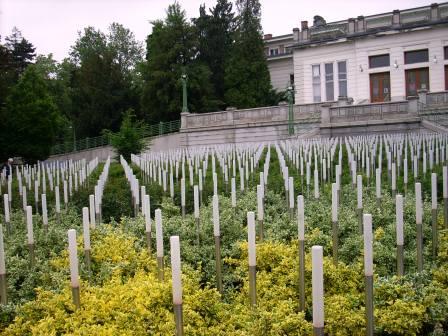
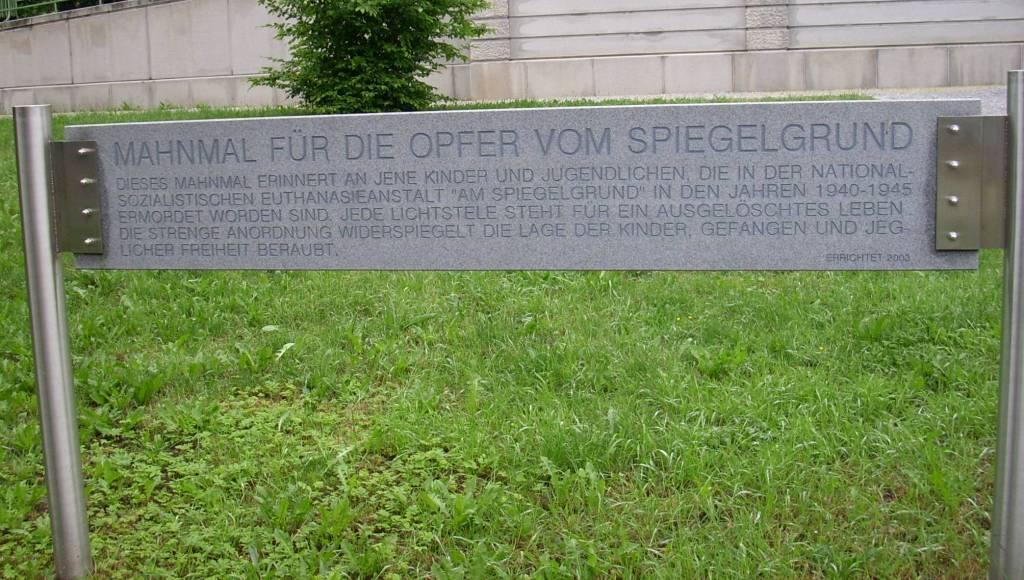 Source: Author's pictures
Source: Author's pictures
The exhibit online was revised and expanded since its inception, and a revised on site exhibit opened in July 2008. A brochure is available.
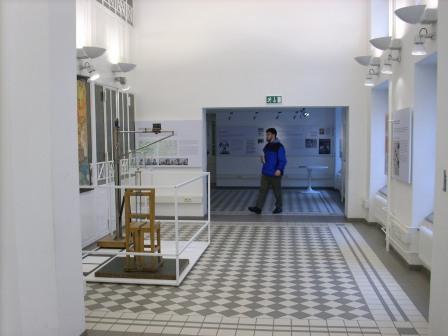 Source: Author's picture
Source: Author's picture
The exhibit includes a part on "children's euthanasia," also available online (in German/English).
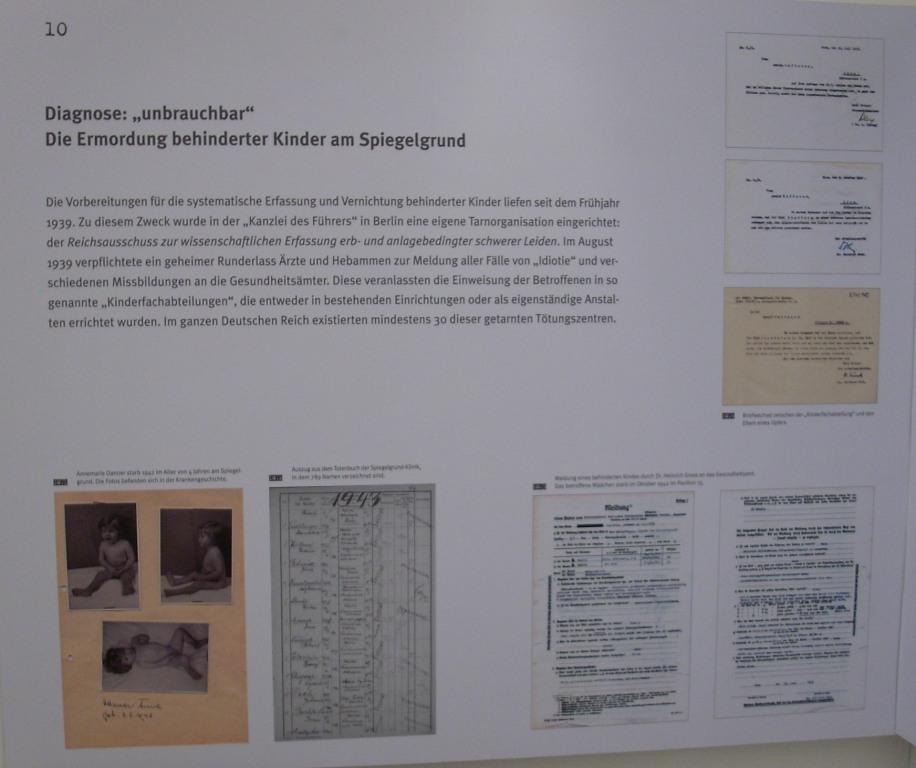 Source: Author's picture
Source: Author's picture
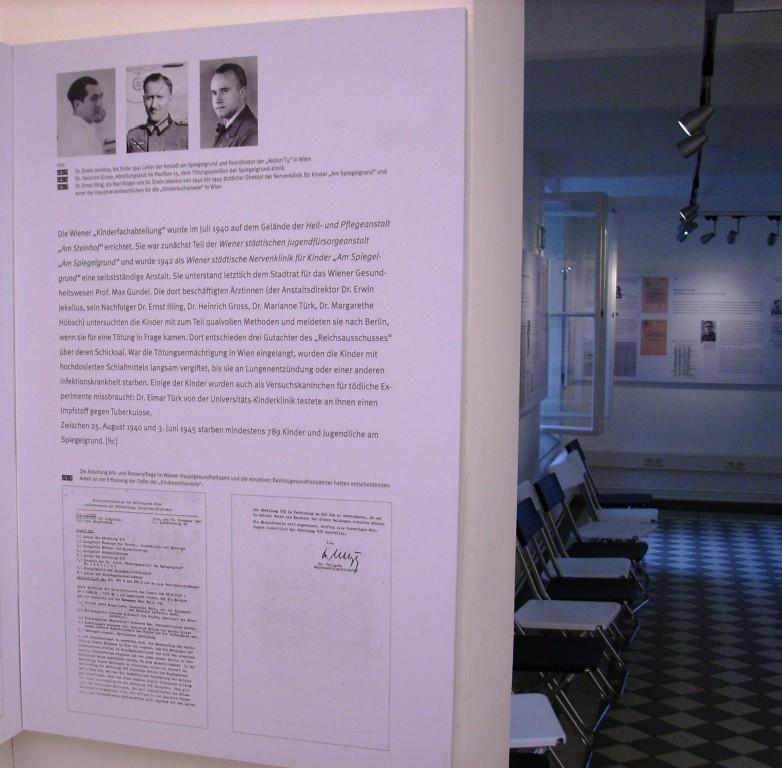 Source: Author's picture
Source: Author's picture
On
site guided tours of the exhibit are offered to visitors (in 2008: 88),
mostly to school classes. Also, at the site Friedrich Zawrel
periodically offers talks about about his personal experiences
with the "Kinderfachabteilung." A report on his talk can be found here.
At the clinic an annual memorial takes place in November. It is
organized by the local district governor of the SPÖ, Andrea Kalchbrenner, and Waltraud Häupl, a
sister to one of the child victims and long-term advocate of
commemoration of these crimes. The choir of the local high school
contributes musical elements and there are reminiscenses of the victims
and their sufferings. The attendants conclude the event by placing white
roses at the field of stelae.
Source: Wolfgang Krisch
The Wiener Stadt- und Landesarchiv put together an exhibit entitled
"Kindereuthanasie in Wien 1940 bis 1945 - Krankengeschichten als
Zeugen" (Children's Euthanasia in Vienna, 1940 -1945: Medical Records
as Witnesses), which was shown there in 2005 and is still available online. The occasion for this exhibit was the transfer of the medical records to the archive.
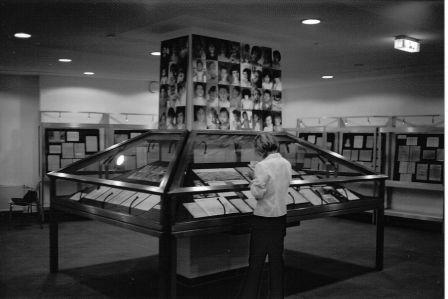 Source: http://www.dnms.no/bilder/org120.jpg
Source: http://www.dnms.no/bilder/org120.jpg
Remarkably, there is also a display right in front of pavilions 15 and
17, detailing some of the events that happened there as part of a
"historical path." One might be led to believe that is was erected
there by the clinic, but it was placed as part of the enlargement of
the public park Steinhofgründe, which borders the clinic and since 2007
extends to some of its greens.
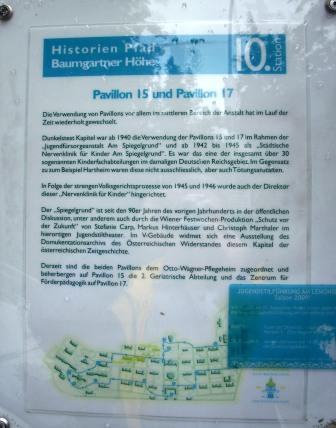 Source: Author's picture
Source: Author's picture
Literature
Benzenhöfer, Udo. 2003. "Genese
und Struktur der
'NS-Kinder- und Jugendlicheneuthanasie.'" Monatsschrift für Kinderheilkunde
151: 1012-1019.
cp-architektur.
2005. "Exhibition e985 gedenkstätte steinhof." Available at http://www.cp-architektur.com/projects/e985_gedenkstaette_steinhof/E985%20gedenkstaette%20steinhof_web.pdf
Czech, Herwig. 2007. "Gedenkstätte Steinhof: Ende eines Provisoriums." Gedenkdienst 4/07. Available at http://www.gedenkdienst.at/index.php?id=522.
———.
2008. "Der Krieg gegen die Minderwertigen: Neueröffnung der
Dauerausstellung zur Geschichte der NS-Medizin im Otto-Wagner-Spital in
Wien." Mitteilungen des Dokumentationsarchivs des österreichischen Widerstandes 188: 1-4. Available at http://www.doew.at/aktuell/mitt/mitt_archiv/188.pdf.
Documentation Center of Austrian Resistance. "Der Krieg gegen
die 'Minderwertigen': Zur Geschichte der NS-Medizin in Wien." Website: http://www.doew.at/projekte/ns_medizin/steinhof.html
Dahl, Mathias.
2004. Endstation Spiegelgrund: Die Tötung behinderter Kinder während des
Nationalsozialismus am Beispiel einer Kinderfachabteilung in Wien 1904 bis 1945.
2nd ed. Vienna: Erasmus.
Gedenkstätte Steinhof. "War Against the 'Inferior': On the History of Nazi Medicine in Vienna". Website: http://www.gedenkstaettesteinhof.at/en/index.shtml
Grey Matter. Dir. Joe Berlinger. 2004.
Häupl, Waltraud.
2006. Die ermordeten Kinder vom Spiegelgrund: Gedenkdokumentation für die Opfer
der NS-Kindereuthanasie in Wien. Vienna: Böhlau.
———. 2008. Der
organisierte Massenmord an Kindern und Jugendlichen in der Ostmark
1940-1945: Gedenkdokumentation für die Opfer der NS-Euthanasie. Vienna: Böhlau.
Kepplinger, Brigitte. 2008. "Gedenkstätten für die Opfer der NS-Euthanasie in Österreich." Pp. 549-99 in Tötungsanstalt
Hartheim, 2nd ed., edited by Brigitte
Kepplinger, Gerhart Marckhgott, and Hartmut Reese. Linz: Oberösterreichisches Landesarchiv.
Krisch, Wolfgang. 2002. "Die Kinder vom Spiegelgrund." Available at http://www.wolfgangkrisch.at/Penzing/04Archiv/Spiegelgrund-Rueckblick,220402.htm
———. 2005. "Kinder vom
Spiegelgrund: Versprochene Forschungsstätte fehlt seit nunmehr 5 Jahren." Available at http://www.wolfgangkrisch.at/Penzing/01Aktuelles,Neuigkeiten/Spiegelgrund-Forschungsstaette_fehlt_seit_5Jahren,23.6.07.htm
Neugebauer,
Wolfgang. 2000. "Zum Umgang mit der NS-Euthanasie in Wien nach 1945." Pp. 107-25 in NS-Euthanasie in Wien, edited by Eberhard Gabriel and Wolfgang Neugebauer..
———, and Georg Stacher. 1999. "Nazi Child 'Euthanasia' in Vienna
and the Scientific Exploitation of its Victims before and after 1945."
Digestive Diseases 17: 279-85.
Oelschläger, Thomas. 2003. "Zur Praxis der NS-Kinder-"Euthanasie" am Beispiel Österreichs." Monatsschrift Kinderheilkunde 10:1033-42.
Rigele, Brigitte. 2005. Kindereuthanasie in Wien 1940–1945: Krankengeschichten als Zeugen. Vienna: Wiener Stadt- und Landesarchiv.
Schölnberger,
Pia. 2008. "'Wir sind doch nicht Frankensteins Nachfolger': Die
Karrieren des Dr. Heinrich Gross (1915-2005)." Pp. 135-47 in Täterschaft -
Strafverfolgung - Schuldentlastung: Ärztebiografien zwischen
nationalsozialistischer Gewaltherrschaft und deutscher
Nachkriegsgeschichte, edited by Boris Böhm and Norbert Haase. Leipzig: Leipziger Universitätsverlag.
Spiegelgrund. Dir. Angelika Schuster and Tristan Sindelgruber. 2000.
Thomas, Florian P., Alana Beres, and Michael I. Shevell.
2006. "’A Cold Wind Coming’: Heinrich Gross and Child Euthanasia in Vienna.”
Journal of Child Neurology 21 (4): 342-48.
Topp, Sascha. 2004. “Der
‘Reichsausschuss zur
wissenschaftlichen Erfassung erb- und anlagebedingter schwerer Leiden’:
Zur
Organisation der Ermordung minderjähriger Kranker im
Nationalsozialismus 1939-1945.”
Pp. 17-54 in Kinder in der NS-Psychiatrie,
edited by Thomas Beddies and Kristina Hübener. Berlin-Brandenburg:
Be.bra
Wissenschaft.
———. 2005. "Der 'Reichsausschuß zur
wissenschaftlichen Erfassung erb-
und anlagebedingter schwerer Leiden': Die Ermordung minderjähriger
Kranker im Nationalsozialismus 1939-1945." Master's Thesis in History,
University of Berlin.
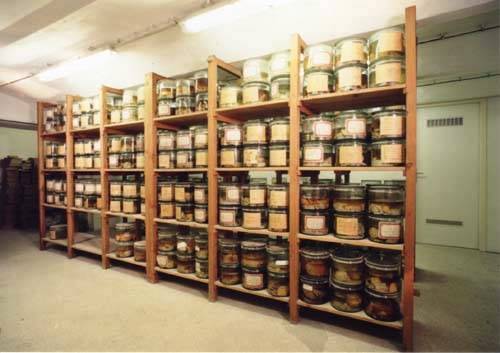
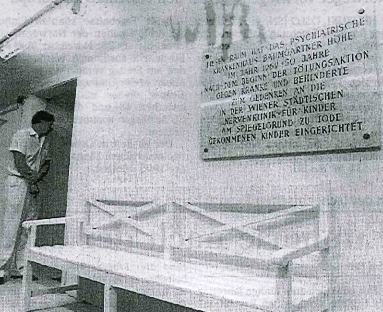








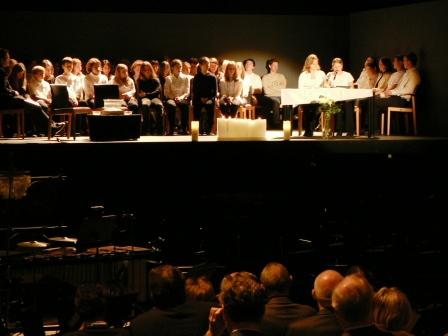
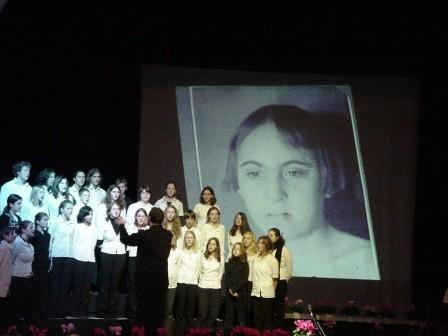
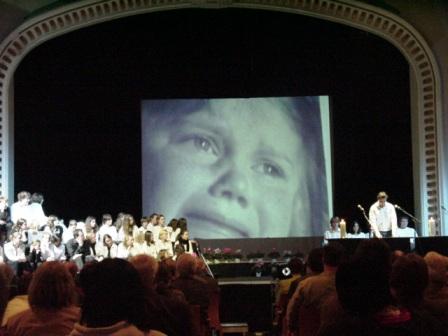
 Source: http://www.dnms.no/bilder/org120.jpg
Source: http://www.dnms.no/bilder/org120.jpg